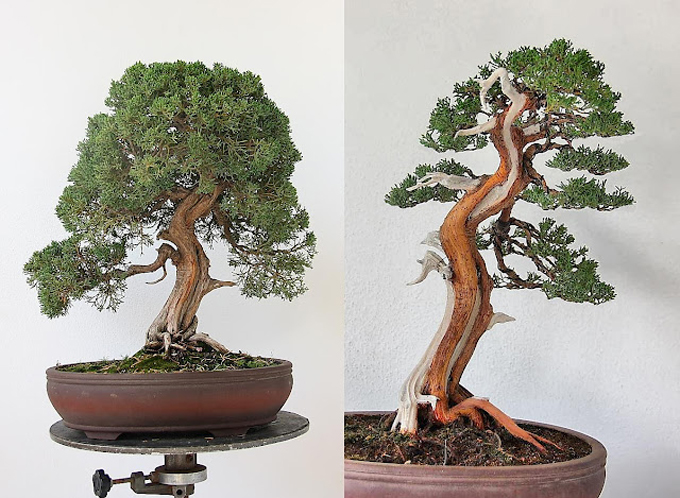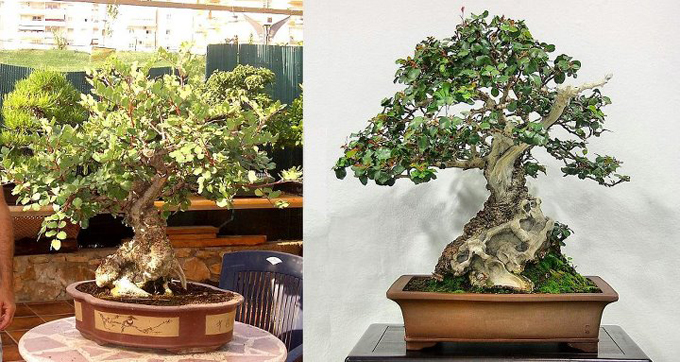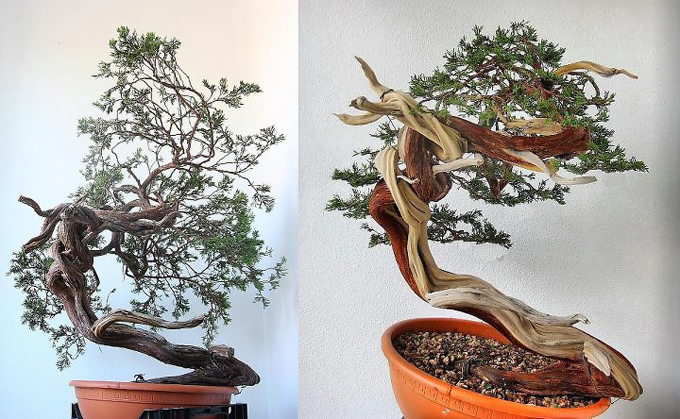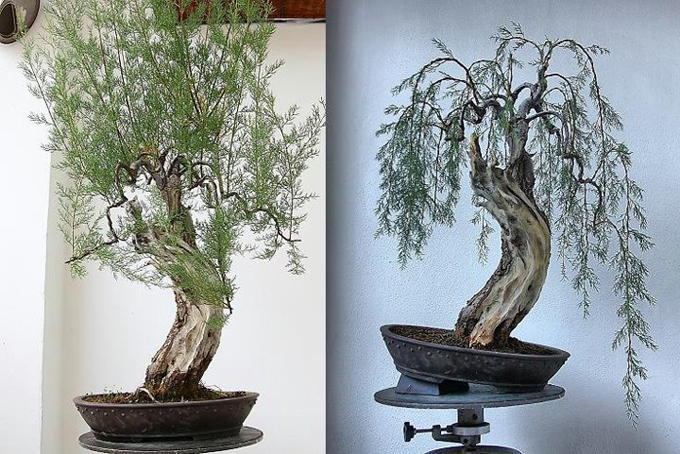 Before & after (antes y depues) Shimpaku juniper by Salvador de los Reyes. You can find all the photos in this post on facebook and on Salvador’s blog.
Before & after (antes y depues) Shimpaku juniper by Salvador de los Reyes. You can find all the photos in this post on facebook and on Salvador’s blog.
The bonsai of Salvador de los Reyes
Thanks to facebook I recently discovered the bonsai of Salvador de los Reyes. I count this as good fortune, especially given that Salvador doesn’t just post on facebook, he also has an excellent bonsai blog (not too many bonsai artists are also successful bloggers).
The upside
There are at least four things you might like about what Salvador de los Reyes is doing:
1. his bonsai are delightful
2. he presents excellent before and after shots
3. he walks you through some very useful bonsai fine points (supported by photos and text)
4. as already mentioned: in addition to facebook posts, he has an excellent blog
The other side
The only possible downside is that Salvador’s posting aren’t in English. This means that if you don’t understand Spanish, you have at least three choices: you can learn Spanish, you can muddle through with Free Translation, or you can just enjoy the photos (I suspect that that’s what most of us do anyway). I guess there’s also a forth choice; you could just ignore Salvador’s bonsai altogether, but that would be a poor choice.
!!!Warehouse vacation reminder!!!
Our warehouse will be closed from Tuesday (day after tomorrow) August 7 thru August 19. Orders received after 3:00 pm (U.S. Eastern Daylight time), August 6th (tomorrow) will be charged and shipped the week of August 20th on a first-come, first-served basis.
 A mystery tree before & after (antes y depues). Salvador identifies most of his trees, but not this one (that I could find at least).
A mystery tree before & after (antes y depues). Salvador identifies most of his trees, but not this one (that I could find at least).
 Sabina juniper before y despues (antes & after). Like all the photos in this post, it’s from facebook.
Sabina juniper before y despues (antes & after). Like all the photos in this post, it’s from facebook.
 A bonsai rarity. Tamarix before & after (antes y depues). You see don’t many Tamarix bonsai and you almost never see a well-styled weeping bonsai.
A bonsai rarity. Tamarix before & after (antes y depues). You see don’t many Tamarix bonsai and you almost never see a well-styled weeping bonsai.
The mystery tree: Although at first sight it looks like an olive, I believe it is what the Spanish call “Encina”, which is an evergreen oak (Quercus ilex), a fairly common species in Spain.
I don’t think it’s an ilex, i had few of those and they grow diferent, also the leafs are not that round.
It looks like a Ceratonia siliqua – Carob. You can see one at Graham’s sale are, number 571.
http://www.kaizenbonsai.com/shop/largetreesforsale.php
Also evergreen…
Hi David,
I took a look and I think you are on to something.
Like Colin, I thought it might be some oak I wasn’t familiar with (though not a Q ilex, the leaf is wrong), but now you and Graham have convinced me (until someone comes up with something better).
Hello friends.
Thank you very much for posting some of my work on your web site.
It is very gratifying for me to find good reviews from outside Spain, thank you again.
Sorry for the mysterious tree, well, the name in spanish is Algarrobo and english is carob (Ceratonia Siliqua), is a common tree here where I live.
Thank you again and best regards
Thanks Salva,
The pleasure is all ours.
And thanks also for clearing up the mystery tree.
BTW: I’m planning at least one more post on your bonsai, so stay posted.
-w
My first thoughts on the mystery tree was that it was a Ceratonia siliqua, but I’d put my money on it being a Schotia (afra or brachypetalia, but more probable the afra).
I’m thankful that I know Spanish. :)
I’ve always wanted to see a carob tree possibly in bonsai form after I read the reference to stunted carob trees in the carob grove on the island of Navarrone in the book “Guns of Navarrone” by Alistair Maclean. Guess I’ve got my wish granted atleast partially. Thanks for sharing.
Rajeev
To my mind the Shimpaku juniper has more character before than after. The mystery tree is fantastic!
Hi Maggie,
I’m not sure I’m with you on the ‘more character before’ idea. However, it’s easy to see that if you were to just open up the crown, the before tree isn’t bad at all. Still…